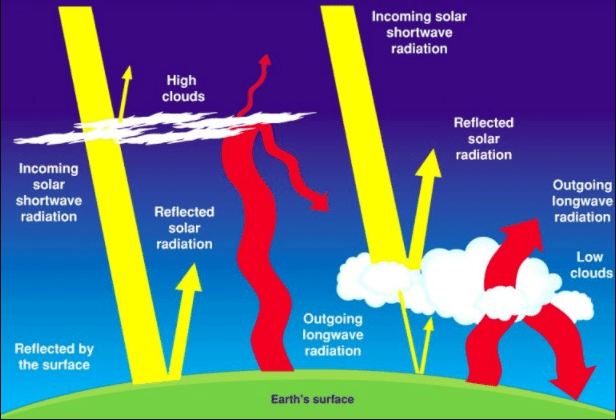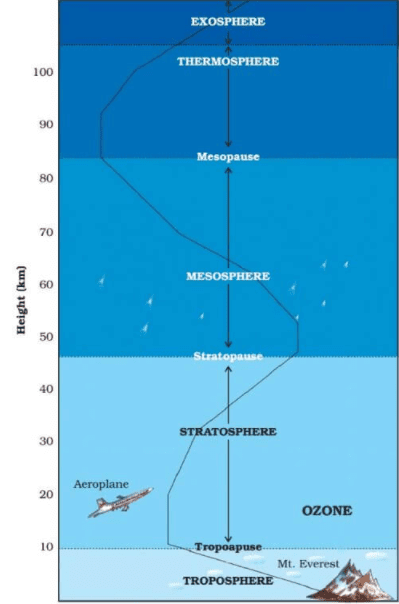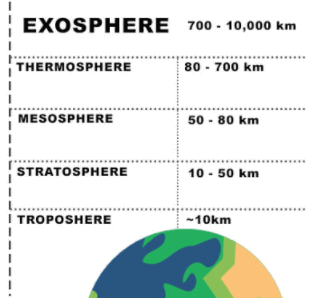Atmospheric Circulation | Geography Optional for UPSC PDF Download
| Table of contents |

|
| Atmosphere |

|
| Atmospheric Particulate Matter |

|
| Structure of the Atmosphere |

|
| Frequently Asked Questions (FAQs) of Atmospheric Circulation |

|
Atmosphere
The atmosphere, a layer of gases surrounding Earth, serves as a protective barrier between our planet and outer space. It is a vital component of the biosphere, as it enables life to exist on Earth's surface. The atmosphere is comprised of colorless, odorless, tasteless, and formless gases that are so thoroughly mixed that they behave as a single gas.
- The gases present in the atmosphere are not direct remnants from Earth's early formation. Instead, they have been produced over time through volcanic eruptions, hot springs, chemical breakdowns of solid materials, and redistribution from the biosphere.
- The atmosphere plays a crucial role in supporting life on Earth. It contains essential gases such as oxygen for humans and animals, and carbon dioxide for plants. The atmosphere also shields Earth from harmful solar radiation and functions as a greenhouse by allowing short-wave radiation from the Sun to enter while trapping long-wave terrestrial radiation emitted from Earth's surface.
- Life forms require specific temperature ranges and solar radiation frequencies to carry out their biological processes. The atmosphere absorbs certain frequencies of solar radiation and allows others to pass through, effectively regulating the solar radiation that reaches Earth's surface. Furthermore, the atmosphere helps maintain temperature stability on Earth's surface, preventing extreme temperature fluctuations between day and night.
- The atmosphere also serves as a protective barrier against extraterrestrial objects, such as meteors, which burn up as they pass through the atmosphere (specifically, the mesosphere) due to friction.
Composition of the atmosphere
The atmosphere is composed of
- Gases
- Vapour
- Particulates
The atmosphere is a mixture of many gases. In addition, it contains huge numbers of solid and liquid particles, collectively called aerosols.
Gases in the Atmosphere
- The atmosphere is primarily composed of nitrogen and oxygen, which together account for nearly 99% of clean, dry air. The remaining 1% consists of mostly inert gases. Oxygen, though it only makes up 21% of the atmosphere, is crucial for life on Earth. It is inhaled by living organisms and forms important compounds, such as oxides, through its ability to combine with other elements. Oxygen is also essential for combustion.
- Nitrogen is the most abundant gas in the atmosphere, comprising 78% of its total volume. Although relatively inert, nitrogen is a key component of all organic compounds. Its primary function is to regulate combustion by diluting oxygen, and it also plays a role in various oxidation processes.
- Carbon dioxide is another important gas, despite constituting only about 0.038% of the dry atmosphere. It is a byproduct of combustion and is absorbed by green plants through photosynthesis for food production and other biological processes. Carbon dioxide has significant climatic implications due to its efficient heat-absorbing properties. The increasing burning of fossil fuels has raised the percentage of carbon dioxide in the atmosphere, which could result in higher temperatures at lower atmospheric levels and lead to significant climate changes. Carbon dioxide and water vapor are primarily found up to 90 km from the Earth's surface.
- Argon is another notable gas, making up approximately 0.93% of the atmosphere. Ozone (O3) is a type of oxygen molecule consisting of three atoms instead of two and constitutes less than 0.00006% of the atmospheric volume. Ozone is unevenly distributed and primarily concentrated between 20 km and 25 km altitude. It is formed at higher altitudes and transported downwards, playing a critical role in blocking harmful ultraviolet radiation from the sun.
- Other trace gases in the atmosphere include neon, helium, hydrogen, xenon, krypton, and methane, which are present in negligible quantities.
Water Vapour
Water vapor is a key component of the Earth's atmosphere, making up anywhere from 0 to 5% of its total volume. This vapor is primarily obtained through the evaporation of water from various sources, such as oceans, seas, lakes, rivers, ponds, and even vegetation and soil.
- The concentration of water vapor in the atmosphere is highly dependent on temperature, which is why it decreases as one moves from the equator towards the poles. For example, in tropical regions near the equator, the surface air contains about 2.6% water vapor, whereas at 50-degree and 70-degree latitudes, the concentrations are 0.9% and 0.2%, respectively.
- Additionally, the amount of water vapor in the atmosphere tends to decrease with altitude. In fact, over 90% of the total atmospheric water vapor is found within the first 5 km above the Earth's surface.
- The presence of water vapor in the atmosphere contributes to various forms of condensation and precipitation, such as clouds, fog, dew, rain, frost, hail, ice, and snowfall. These phenomena occur when the moisture content in the atmosphere reaches a certain level and temperature conditions are favorable.
- An interesting property of water vapor is its transparency to incoming shortwave solar radiation. This means that the sun's electromagnetic waves can pass through the atmosphere and reach the Earth's surface with little interference from water vapor. However, water vapor is less transparent to outgoing longwave terrestrial radiation, which is emitted by the Earth's surface as it absorbs solar energy. As a result, water vapor plays a crucial role in warming the Earth's surface and lower atmosphere by absorbing and retaining this terrestrial radiation.
In summary, water vapor is an essential component of the Earth's atmosphere, with its concentration varying depending on factors such as temperature and location. It plays a vital role in the formation of various weather phenomena and contributes to the Earth's overall climate by regulating the absorption and retention of solar and terrestrial radiation.
 Water Vapour & Solar Radiation
Water Vapour & Solar Radiation
Atmospheric Particulate Matter
- The atmosphere contains solid particles such as sand (from weathered rocks and volcanic ash), pollen grains, tiny organisms, soot, ocean salts, and even fragments of meteors that have burned up in the atmosphere. These particulates play a crucial role in absorbing, reflecting, and scattering solar radiation, which creates the beautiful red and orange hues seen during sunrise and sunset.
- The blue color of the sky is a result of the selective scattering of solar radiation by dust particles. Additionally, salt particles serve as hygroscopic nuclei, which aid in the formation of water droplets, clouds, and different types of condensation and precipitation.
- A hygroscopic nucleus is a microscopic particle, such as sulfur dioxide, salt, dust, or smoke, that serves as a platform for water vapor to condense into droplets.
Structure of the Atmosphere
The atmosphere is composed of various layers that can be categorized based on their composition, density, pressure, and temperature differences.
Composition-wise, the atmosphere can be broadly divided into two main layers: the homosphere and the heterosphere.
- The homosphere consists of three regions: the Troposphere, the Stratosphere, and the Mesosphere. While the air composition remains consistent throughout these regions, the concentration of air significantly diminishes with an increase in altitude.
- The Troposphere is the lowest layer of the atmosphere and is responsible for Earth's weather as it contains most weather conditions. The temperature decreases as altitude increases in this region.
- The Stratosphere is situated in the middle of the homosphere, while the Mesosphere is its uppermost layer.
- The heterosphere, on the other hand, contains two regions: the Thermosphere and the Exosphere. These regions are considered part of outer space and have unevenly mixed gases. The Ionosphere overlaps both the Mesosphere and the Thermosphere.
- The Thermosphere is the lower region of the heterosphere, while the Exosphere is its uppermost region.
- The homosphere extends from Earth's surface up to an altitude of 80 km. Although the atmosphere's density rapidly diminishes with an increase in altitude, the gas composition remains uniform within the homosphere. Exceptions to this uniformity include the concentration of ozone (O3) in the stratosphere from roughly 19-50 km and the variation of water vapor and dust particles in the lower atmosphere. This uniform composition was achieved around 600 million years ago.
- The heterosphere begins at an altitude of over 80 km and extends up to 10,000 km. However, for scientific purposes, the atmosphere's upper limit is considered to be 480 km, as Earth's gravitational pull becomes negligible beyond this point. The atmosphere above this limit is referred to as the exosphere and contains individual atoms of lightweight gases such as hydrogen and helium.
 Earth Atmosphere
Earth Atmosphere
Based on Change in temperature
The atmosphere is composed of five distinct layers, each characterized by variations in temperature and density. These layers include:- Troposphere: This is the lowest layer of the atmosphere, where weather occurs and temperature decreases with altitude.
- Stratosphere: Above the troposphere, this layer features a temperature increase with altitude and contains the ozone layer.
- Mesosphere: In this layer, temperatures decrease with altitude, and it is the region where meteors burn up upon entering Earth's atmosphere.
- Thermosphere (Ionosphere): The temperature rises significantly in this layer due to solar radiation absorption. It is also known as the Ionosphere because it contains charged particles that enable radio wave communication.
- Exosphere: This is the outermost layer of the atmosphere, where temperatures remain constant with altitude, and the density of air particles is extremely low.

Structure of the Atmosphere
Troposphere:
- The troposphere is the lowest layer of Earth's atmosphere, extending up to 18 km at the equator, 13 km at mid-latitudes, and approximately 8 km at the poles. This layer contains around 90% of the atmosphere's total mass and is the region where all weather phenomena occur, such as the presence of water vapor, dust particles, and clouds.
- In the troposphere, temperature decreases as altitude increases. The average rate of this temperature decrease is called the normal lapse rate, which is roughly 6.4 degrees Celsius per kilometer. However, this rate is not constant everywhere, and the specific rate of temperature decrease in a particular location is referred to as the local lapse rate. The minimum temperature reached in the troposphere is around -57 degrees Celsius.
- The tropopause is the upper boundary of the troposphere, separating it from the stratosphere above. This boundary is characterized by a constant temperature, acting as a transitional zone between the two atmospheric layers.
Stratosphere
- The stratosphere is a layer of Earth's atmosphere situated above the troposphere and extending up to 50 kilometers across the globe. In this region, temperatures rise as altitude increases, ranging from -57 to 0 degrees Celsius.
- A key feature of the stratosphere is the presence of the ozonosphere, which consists of highly reactive ozone molecules composed of three oxygen atoms. The ozone layer plays a critical role in absorbing high-frequency ultraviolet (UV) radiation, which leads to an increase in temperature within the stratosphere.
- The absorption of energy by the ozone molecules causes chemical reactions that result in the formation of ozone gas. By absorbing harmful UV rays, the ozone layer serves as a protective barrier for living organisms, including plants, animals, and humans, shielding them from the detrimental effects of these ultraviolet radiations.
 Layers of Atmosphere
Layers of Atmosphere
Mesosphere
- The mesosphere is a layer of Earth's atmosphere that stretches from 50 to 80 kilometers above the surface. Within this layer, the temperature decreases, reaching an average low of -90°C, although it can vary.
- This layer is part of a homogenous region that extends up to the mesosphere. At the upper boundary of the mesosphere, there is a layer of charged particles, also known as ions, that extends into the next atmospheric layer. This ion layer plays a significant role in reflecting radio waves, which is crucial for telecommunications.
Thermosphere
- The thermosphere is a region that spans from 80 km to 480 km above the Earth's surface. Within this region, the ionosphere functions due to the presence of charged particles. As the gas molecules in this layer absorb shortwave solar radiation, the temperature dramatically increases, possibly reaching up to 1200°C.
- However, the thermosphere does not feel as hot as one might expect, given its high temperatures. This is because the air density in this layer is extremely low, resulting in a reduced ability to transfer energy. Consequently, the sensation of heat is not experienced as it would be in denser regions.
Ionosphere
- The ionosphere is a region of the Earth's atmosphere, extending from the upper mesosphere to the lower thermosphere, approximately 60 to 400 kilometers (40 to 250 miles) above the Earth's surface. It contains charged particles, known as ions, which are created by the absorption of cosmic rays, gamma rays, X-rays, and ultraviolet rays with shorter wavelengths.
- This layer of the atmosphere is crucial for long-distance communication, as it reflects radio waves back to Earth, enabling signals to travel across vast distances. The ionosphere is also responsible for the beautiful auroral displays, such as the "northern lights," which occur when charged particles from the Sun are trapped by Earth's magnetic field near the poles. These particles "excite" nitrogen molecules and oxygen atoms in the ionosphere, causing them to emit light in a similar fashion to a neon light bulb.
- As we move higher within the ionosphere, atomic oxygen becomes more prevalent at altitudes above 480 kilometers (298 miles). Beyond this point, helium becomes more common, followed by a predominance of hydrogen atoms. One notable phenomenon that occurs within the ionosphere is the heating of incoming space vehicles and meteorites due to friction with the charged particles.
Exosphere
- The exosphere is the highest layer of the atmosphere, where gases are extremely sparse due to the minimal influence of gravitational forces.
- As a result, the air density in this region is significantly lower compared to other atmospheric layers.

Conclusion
Earth's atmosphere is a complex and essential component of the biosphere, providing a protective barrier and supporting life on the planet. Composed of various gases, water vapor, and particulate matter, the atmosphere is divided into distinct layers based on composition, temperature, and density. Each layer plays a crucial role in maintaining temperature stability, shielding Earth from harmful radiation, and enabling various weather phenomena and long-distance communication. Understanding the structure and functions of the atmosphere is vital for monitoring and addressing climate change and other environmental challenges.Frequently Asked Questions (FAQs) of Atmospheric Circulation
What are the primary gases that make up Earth's atmosphere?
The Earth's atmosphere is primarily composed of nitrogen (78%) and oxygen (21%). The remaining 1% consists of other gases like argon, carbon dioxide, and trace amounts of other gases such as neon, helium, hydrogen, xenon, krypton, and methane.
What is the importance of the ozone layer in Earth's atmosphere?
The ozone layer, located within the stratosphere, is essential because it absorbs high-frequency ultraviolet (UV) radiation from the Sun. By doing so, it protects living organisms on Earth, including plants, animals, and humans, from the harmful effects of these UV rays.
How does the atmosphere contribute to the Earth's overall climate?
The atmosphere, particularly water vapor, plays a crucial role in regulating the Earth's climate by absorbing, reflecting, and scattering solar radiation. It also helps maintain temperature stability on Earth's surface by allowing short-wave radiation from the Sun to enter while trapping long-wave terrestrial radiation emitted from Earth's surface.
How does the ionosphere enable long-distance communication?
The ionosphere contains charged particles, or ions, which are created by the absorption of cosmic rays, gamma rays, X-rays, and ultraviolet rays with shorter wavelengths. These charged particles reflect radio waves back to Earth, enabling signals to travel across vast distances and facilitating long-distance communication.
What is the difference between the homosphere and the heterosphere in Earth's atmosphere?
The homosphere is the region of the atmosphere that extends from Earth's surface up to an altitude of 80 km. In this region, the gas composition remains uniform, with some exceptions such as the concentration of ozone in the stratosphere. The heterosphere begins at an altitude of over 80 km and extends up to 10,000 km, where gases are unevenly mixed due to the minimal influence of gravitational forces.
|
303 videos|636 docs|252 tests
|
FAQs on Atmospheric Circulation - Geography Optional for UPSC
| 1. What is atmospheric particulate matter? |  |
| 2. How does atmospheric particulate matter affect human health? |  |
| 3. What is the structure of the atmosphere? |  |
| 4. How does atmospheric circulation occur? |  |
| 5. What is the significance of understanding atmospheric circulation? |  |





















